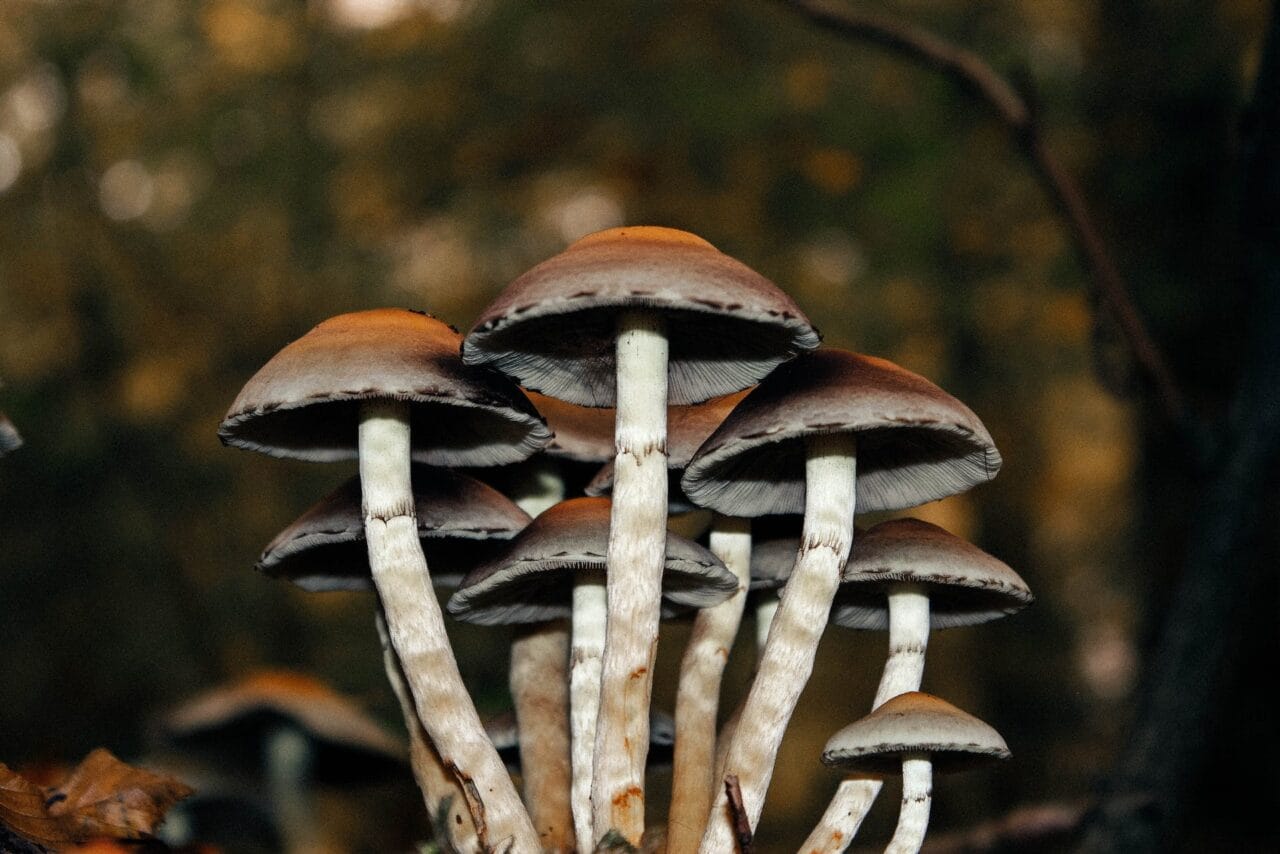Psilocybin, a psychedelic substance present in magic mushrooms, is often used recreationally for its euphoric and hallucinatory effects.
Aside from its mind-altering properties, the potential of this compound as a treatment for chronic pain has been the subject of research.
This article delves into a case study that investigates the potential of microdosing mushrooms in managing chronic pain.
Key Takeaways:
- Microdosing mushrooms could potentially provide both immediate and sustained relief from pain.
- Psilocybin microdosing generally has fewer side effects compared to traditional pain medications when administered in small doses.
- Psilocybin works by interacting with the serotonin 2A (5-HT2A) receptors to help alleviate pain, among other things.

The Study
The research, “Microdosing Psilocybin for Chronic Pain: A Case Series“, was led by Dr. Matthew Lyes and his team from the Division of Pain Medicine in the Department of Anesthesiology at the University of California, San Diego. The study focused on three patients who self-medicated with small doses of psilocybin to manage their chronic pain.
Three Patients, One Result – Reduction of Chronic Pain
Patient # 1
| AGE/ GENDER: | 37, Male |
| TYPE OF PAIN: | Neuropathic pain appearing below the site of a spinal cord injury. |
| PAIN LEVEL: | Starting at 4 to 5/ 10, increasing to 8/ 10 later in the day |
| PSILOCYBIN DOSE: | 250 mg of ground mushroom for under 6 months |
| RESULT: | Discontinued use of prescribed pain medication, reduced muscle spasms, and improved bowel function. No signs of rebound pain or withdrawal symptoms were observed. |
| The patient reported that while his regular medications only managed to dull the pain, psilocybin effectively silenced it, reducing his average pain level from 5 to 0. | |
Case Study: Subject #2
| AGE/GENDER: | 69-year-old female |
| PAIN TYPE: | Complex Regional Pain Syndrome (CRPS) |
| PAIN INTENSITY: | Typically between 5 and 7 out of 10, but increases with physical activity and during pain flare-ups |
| PSILOCYBIN DOSAGE: | 500 mg daily for 7-10 days, followed by rest periods (2-3 days) over a year. Dosage increases to 750 mg to 1 gram during pain flare-ups |
| EFFECT: | 80% reduction in pain for 3-4 hours, with pain levels gradually returning to initial levels after 12 hours. Complete pain relief (90%-100%) lasts 6-8 hours, returning to initial levels after 18 hours. |
| The patient experiences reduced appetite without nausea. Disorientation or instability in movement is observed when the dosage is increased (750 to 1000mg). | |
Case Study: Subject #3
| AGE/GENDER: | 40-year-old female |
| PAIN TYPE: | Lumbar radiculopathy and neuropathic pain |
| PAIN INTENSITY: | 8 out of 10, escalating to 10 out of 10 during physical activity |
| PSILOCYBIN DOSAGE: | 1000 mg from a mushroom chocolate bar every two months. |
| EFFECT: | Significant pain relief without psychoactive effects. Noted increase in flexibility and functionality. Pain gradually returns to initial levels over 2-4 weeks. Repeated dosing improves control over pain. |
| The patient did not experience any noticeable physical, cognitive, or behavioural side effects. Her mood remained largely stable. She maintained her regular dosage of her SSRI for depression management throughout the psilocybin treatment period. | |
Decoding Pain Management with Psilocybin
Continuous signals of somatic and visceral pain strengthen specific neural pathways due to peripheral and central sensitization. This results in the chronic sensation of physical and emotional pain. Psychedelics like psilocybin trigger 5-HT2A receptors, potentially rebooting brain areas linked with neuropathic conditions.
One patient reported enduring pain relief lasting for weeks. This suggests that after directly activating the 5-HT2A receptors, there can be central regulation of pain perception and
Possible Side Effects of Psilocybin vs Traditional Pain Relievers
| PSILOCYBIN (Based on Studies) | TRADITIONAL PAIN RELIEVERS |
| Muscle spasms | Nausea |
| Decreased appetite | Stomach discomfort |
| Confusion | Headaches |
| Unsteady gait | Dependency |
| No mood changes | Drowsiness |
Potential Future Investigations into Psilocybin
The researchers, based on the experiences of three individuals, have identified possible areas of study that may prove beneficial and warrant further scrutiny.
- Small doses of psilocybin could provide immediate and possibly sustained relief from neuropathic pain, without leading to physical tolerance or addiction.
- Examine the impacts of different treatment techniques in conjunction with psilocybin. For example, patient # 3 experienced an amplified analgesic effect when psilocybin was used in combination with physical therapy.
- Even without psychotherapy, small doses of psilocybin may offer pain relief, as illustrated by this case study. The researchers posit that incorporating therapeutic guidance could potentially enhance or prolong the therapeutic outcomes.
Study Limitations
Despite the encouraging outcomes observed in the patients, it’s crucial to take into account the limitations acknowledged in the study.
- The limited sample size may not thoroughly represent the entire population suffering from neuropathic pain.
- The study did not encompass any subjects who did not respond to psilocybin.
- No assessments were done before and after the treatment to gauge the impact of psilocybin on psychiatric conditions such as depression and anxiety.
- Most of the data was self-reported by the subjects.
- The presence of the interviewer and potential biases linked to psilocybin could have influenced the participants’ responses.
- The study did not delve into the potential influence of the placebo effect.
- The study did not measure the quantity of psilocybin in each mushroom.
Microdosing with Psilocybin Mushrooms
In our study, we observed that participant 1 and participant 2 consumed a microdose of psilocybin in a powdered form that was extracted from dried mushrooms. On the other hand, participant 3 combined their psilocybin with chocolate. There are numerous products available for psilocybin microdosing, and we’ve gathered a short list of some of them below.
Dried Psilocybin Mushrooms
Although the study didn’t clarify the specific strain utilized, the strain highlighted below is a recommended starting point for beginners.
- Golden Teacher: This strain is one of the most popular and frequently encountered varieties of magic mushrooms.
- Amazonian Cubensis: This strain is known for its user-friendliness and potential cognitive benefits.
- Cambodian: Microdosing with Cambodian cubensis mushrooms could boost concentration, social awareness, and mood.
Psilocybin Microdose Capsules
- Euphoria Psychedelics – Micro Calm Capsules: This concoction contains Ashwagandha, Reishi, CBD, Valerian root, and Psilocybin Mushrooms, all of which are scientifically demonstrated to decrease anxiety and stress.
- Ground Sounds – Microdose Capsules – Champion Lover: This intriguing blend offers three dosage options: 50mg, 100mg, or 250mg of pure psilocybin complemented with reishi, cacao, cordyceps, and maca.
- Kind Stranger – Brighten Capsules 250mg: These capsules utilize the Golden Teacher strain, which is known for promoting mental clarity, enhanced creativity, and increased focus.
Using Psilocybin for Pain Relief
Even though studies on the pain-alleviating properties of psilocybin mushrooms are still in preliminary stages, promising anecdotal evidence and small-scale case studies are emerging.
Such instances underscore the importance of continuing research into the potential advantages of psilocybin, class=”wp-block-list”>
Especially in the context of chronic pain management, the potential of psilocybin is becoming increasingly recognized.
Before the widespread endorsement of psilocybin as a pain relief method, optimistic reports from case studies have been a source of hope for those living with chronic pain.
Frequently Asked Questions
What are the effects of microdosing psilocybin?
Psilocybin chiefly activates a serotonin receptor, known as “5-HT2A”, in the prefrontal cortex, leading to two primary outcomes:
- Generation of “Brain-Derived Neurotrophic Factor” (BDNF)
- Enhanced “Glutamate” transmission
Moreover, psychedelics promote connections among brain regions that typically interact less frequently. This distinctive connectivity is a consequence of psychedelics’ ability to decrease the activity of the “Default Mode Network” (DMN), which is associated with various cognitive functions such as daydreaming, introspection, and reflecting on the past and future.
What is the most recognized benefit of microdosing mushrooms?
Microdosing may enhance mood, productivity, creativity, and focus. Its most extensively researched benefit is its influence on mental health.
In November 2022, the mental health company, COMPASS Pathways, released the findings of their thorough phase 2b trial, a randomized and double-blind study. Their investigation suggested that a single psilocybin dose significantly reduced depressive symptoms compared to a placebo. Participants who received a higher 25-milligram dose showed a persistent antidepressant response at their twelve-week follow-up.
A study published in the Psychiatry Research Journal indicated that psilocybin is more effective than traditional antidepressant treatments.
How should you determine your dosage?
Start with a 0.1-gram dose of psilocybin mushrooms on the first day. If the desired effects are not reached, increase your dosage by 0.05 grams on subsequent microdosing days until you reach your optimal level.
Those with prior experience with psychotropic drugs may need to increase the dosage to 0.5 grams to achieve the desired effects.
What precautions should be taken before consuming mushrooms?
class=”wp-block-list”>What is the suggested frequency for taking microdoses of mushrooms?
A variety of well-accepted protocols recommend structured microdosing schedules for psychedelics. These protocols primarily vary in the number of “off” days they incorporate, which are the days when you abstain from microdosing.
The most commonly suggested protocols propose including 1-3 rest days between microdoses. This aligns with the body’s natural tolerance mechanisms. The three protocols under consideration in this context are the Fadiman Protocol, the Stamets Stack, and intuitive microdosing.




